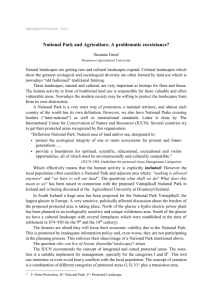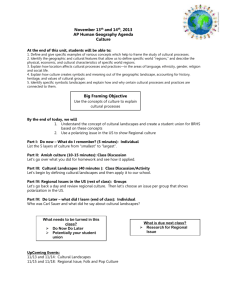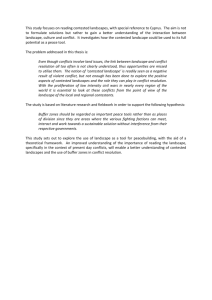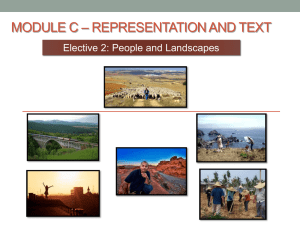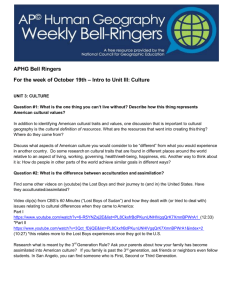Neutral Landscape Models Paper 3rd Draft
advertisement
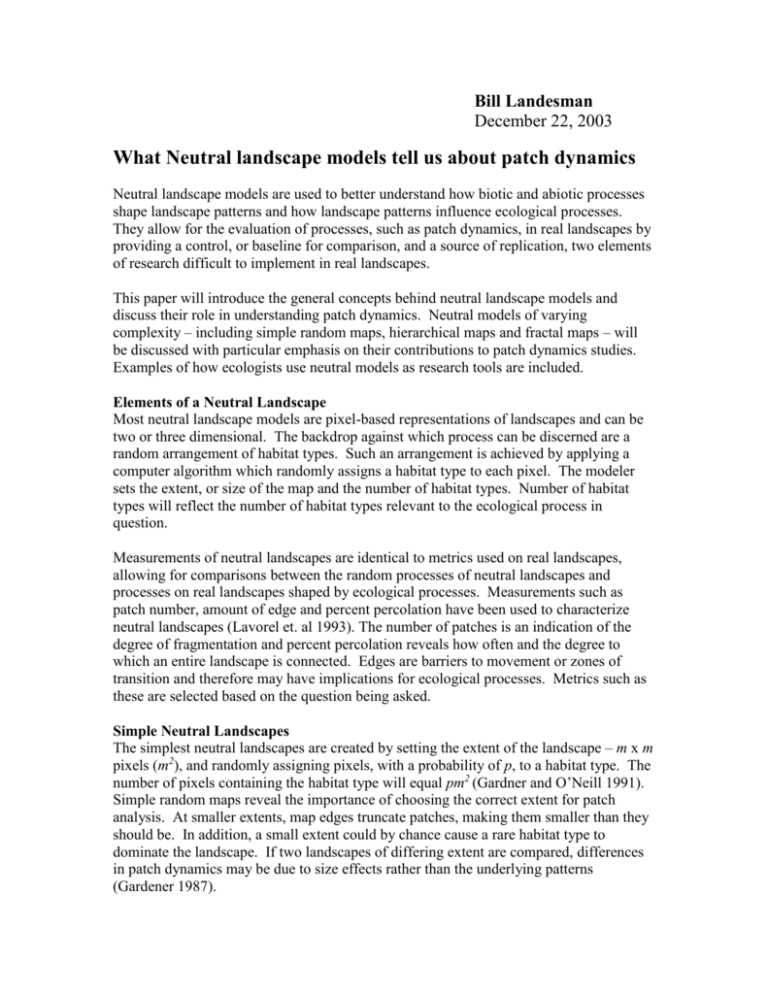
Bill Landesman December 22, 2003 What Neutral landscape models tell us about patch dynamics Neutral landscape models are used to better understand how biotic and abiotic processes shape landscape patterns and how landscape patterns influence ecological processes. They allow for the evaluation of processes, such as patch dynamics, in real landscapes by providing a control, or baseline for comparison, and a source of replication, two elements of research difficult to implement in real landscapes. This paper will introduce the general concepts behind neutral landscape models and discuss their role in understanding patch dynamics. Neutral models of varying complexity – including simple random maps, hierarchical maps and fractal maps – will be discussed with particular emphasis on their contributions to patch dynamics studies. Examples of how ecologists use neutral models as research tools are included. Elements of a Neutral Landscape Most neutral landscape models are pixel-based representations of landscapes and can be two or three dimensional. The backdrop against which process can be discerned are a random arrangement of habitat types. Such an arrangement is achieved by applying a computer algorithm which randomly assigns a habitat type to each pixel. The modeler sets the extent, or size of the map and the number of habitat types. Number of habitat types will reflect the number of habitat types relevant to the ecological process in question. Measurements of neutral landscapes are identical to metrics used on real landscapes, allowing for comparisons between the random processes of neutral landscapes and processes on real landscapes shaped by ecological processes. Measurements such as patch number, amount of edge and percent percolation have been used to characterize neutral landscapes (Lavorel et. al 1993). The number of patches is an indication of the degree of fragmentation and percent percolation reveals how often and the degree to which an entire landscape is connected. Edges are barriers to movement or zones of transition and therefore may have implications for ecological processes. Metrics such as these are selected based on the question being asked. Simple Neutral Landscapes The simplest neutral landscapes are created by setting the extent of the landscape – m x m pixels (m2), and randomly assigning pixels, with a probability of p, to a habitat type. The number of pixels containing the habitat type will equal pm2 (Gardner and O’Neill 1991). Simple random maps reveal the importance of choosing the correct extent for patch analysis. At smaller extents, map edges truncate patches, making them smaller than they should be. In addition, a small extent could by chance cause a rare habitat type to dominate the landscape. If two landscapes of differing extent are compared, differences in patch dynamics may be due to size effects rather than the underlying patterns (Gardener 1987). Simple neutral models demonstrate that, for any given landscape, there will be a percentage of habitat cover below which connectivity is not geometrically possible. For example, when p, the probability of a given habitat type occurring in any given cell, is .5829 or higher, and the four nearest neighbor rule is used, one large patch will span, or percolate, across the entire map. In other words, when the landscape is at least 58% occupied with a particular habitat type, that habitat will form one connected patch. Below the threshold value, or p-crit, fragmentation will occur (Gardener 1987). Using simple random maps, Turner et. al (1989) found that a disturbance can easily spread throughout a connected landscape even at low intensities of disturbance. With increasing fragmentation, disturbance is less likely to spread. Even high intensity disturbances in fragmented landscapes may be less likely to propagate the disturbance when compared to low intensity disturbances on a connected landscape. In his review of the literature, Andren (1994) found that approximately 30% habitat is the minimum necessary for most animals to perceive a connected landscape. This is substantially less habitat than simple neutral landscapes predict, and is explained by the fact that animals can move between patches. With et. al (1999) uses the terms “structural connectivity” and “functional connectivity” to make the distinction between patches that are physically touching and those that are connected by an organisms’ dispersal ability. Simple neutral landscapes provide the predicted value for connectivity and a baseline against which real landscapes can be evaluated. The difference in percolation found by Andren, in turn, are explained by ecological processes. While neutral landscapes allow for a deeper understanding of patch dynamics which consider the organisms’ perspective, this information can be used to improve future neutral landscapes. For example, the nearest neighbor rule can be altered to more accurately reflect an organisms dispersal ability. Depending on the organisms being studied, connectivity may not be relevant. With and Crist (1995), for example, used simple neutral landscapes to demonstrate that total habitat abundance was more important than connectivity for a resource specialist. A specific habitat type was needed for food and/or shelter and although the organism may perceive fragmentation, they are more likely to be limited by habitat abundance. P-crit was only important for resource generalists. This was because most habitat types could be exploited and dispersal through the landscape was required to obtain a sufficient amount of resources. Gardner’s (1989) simulation of animal movements further demonstrate that connectivity is not always the most important landscape metric. To more accurately study animal interactions with landscapes he used simulated animal walks across simple neutral maps. The likelihood of dispersal across a completely connected landscape was reduced by increasing extent. Since the landscape was longer, it simply took more time for the organism to cross it, and there were more opportunities for the organism to change direction. Changes in grain had even more profound affects, with finer grain sizes – corresponding to the behavior of smaller organisms - decreasing the likelihood of successful dispersal across a connected landscape. Hierarchical Maps As demonstrated by simple random maps, ecological processes occur over multiple scales. That is, processes are influenced by the grain, or smallest resolvable unit in the landscape, and extent, or size of the patch, landscape or map. Neutral landscapes can be designed which include multiple scales providing a comparison against which scale effects in real landscapes may be evaluated. Hierarchical maps are neutral landscape models with different patch sizes representing different extents. They come closer to representing real landscapes in this respect, but assignment of habitat at each scale remains a random process. Hierarchical maps are created by defining the number of scales, or levels (L) and these levels usually refer to differences in the extent, or size, of patches. At each level, random assignments of p are made and the value of p decreases with decreasing L. The proportion of habitat for the entire landscape - P - will be the product of the p’s at each scale. With hierarchical maps, percolation over the entire map can occur at much lower values than p-crit of simple neutral landscapes (Lavorel et al, 1993). By adding multiple scales to a map, values of p-crit become more variable. Such landscapes can percolate below .5829 and do not necessarily percolate above this value (O’Neill et al, 1992). Thus the structure of real landscapes can have a more variable affect on the connectivity of patches. Depending on the nature of the landscape structure, patches can be highly connected at low percentages of habitat or very patchy at high percentages of habitat. Hierarchical neutral models can be used to determine how different organisms, operating at different scales in the landscape, are affected by fragmentation, or the increase in number of patches (With, 1997). An increase in the number of small patches is unlikely to influence organisms that utilize resources over a large extent and the fragmentation of large patches most likely will not affect organisms which need small patches for survival. By manipulating the size, or extent of patches, hierarchical neutral landscapes allow for the determination of what constitutes small and large patches by considering the requirements of the organisms occupying the landscape. Gustafson and Gardner (1996) used hierarchical neutral maps to evaluate animal dispersal from a preferred forest patch through a matrix of six non-forest habitat types to another forest patch. They found that dispersal was less likely to occur through the hierarchically structured map. Even when increasing the animals’ tolerance for habitat types, simulated organisms were more likely to perceive a more patchy and unconnected landscape when compared to simple random maps. Dispersal success decreased with increasing interpatch distance as well. The hierarchical maps further showed that the uneven arrangement of habitat allowed for asymmetrical movement of animals in one direction over another. The ability for neutral landscape models to discern such phenomena provided for a better prediction of animal movements than the theory of island biogeography. Lavorel et al (1993) determined that the scale controlling patch dynamics would be the level below the one at which percolation occurred. For example, in a map with three arbitrarily defined patch levels where percolation occurred over the large scale, it would be the middle scale where variables such as patch size, patch number and amount of edge would depend upon biotic and abiotic factors operating at that scale. Fractal Maps While hierarchical landscapes incorporate scales that are independent of one another, real landscapes may demonstrate self-similarity across scale. That is, landscape patterns may be repeated over multiple scales. Hierarchical or random maps randomly intersperse multiple habitat types. In real landscapes, different habitats tend to transition into one another. Fractal landscapes add an additional layer of reality by incorporating parameters for self-similarity and transitioning (With, 1997). The self-similarity of real landscapes are expressed in fractal landscapes by H, or the Hurst constant (With et. al. 1999), which ranges in value from 0 to 1. High values of H correspond to a high degree of self-similarity in the landscape resulting in a high degree of clumping in the landscape. Landscapes with more self-similarity tend to be more connected that landscapes with less autocorrelation (With et. al. 1999). With (1997) demonstrated differences in extent between random and fractal maps by populating patches using organisms with varying habitat preferences and dispersal abilities. At a small extent, random maps contained more aggregation of organisms but at a larger extent fractal maps were more aggregated. This follows logically from the structure of the maps. In the random maps, self-similarity occurred at the small scale only. Organisms tended to remain in patches as long as resources were available. Selfsimilarity occurred over a larger area in the fractal maps and aggregation of populations could occur over a much larger scale. With (1997), found that large scale fragmentation tended to maintain connectivity in the landscape whereas small scale fragmentation increased the number of unconnected patches. This increased number of patches made dispersal difficult for some organisms. King and With (2002) compared dispersal patterns between fractal and simple random maps. Dispersal from one suitable habitat to another was more likely on fractal landscapes when organisms were constrained to moving through habitat connected by a side. In other words high connectivity was needed and fractal landscapes tend to have this greater connectivity. These landscapes, in turn, are more representative of real landscapes where similar habitats tend to be aggregated, or more connected. With and King (1999) compared neutral fractal landscapes to random landscapes as well. They found that, compared to randomly distributing organisms on randomly arranged maps, dispersal success was generally higher on fractal landscapes for species dispersing through one of the four nearest neighbors. The study highlights the improved value of neutral landscapes over metapopulation models, which assume random dispersal and random habitat arrangement. With et. al. (1999) created fractal landscapes in the field using grass and sand. Large and small crickets were placed in the landscape and their dispersal patterns were observed. Total percent grass and degree of patchiness (changing H) were manipulated in the landscapes. While large crickets were unaffected by total grass cover, small crickets were. This was attributed to the fact that the small crickets had a smaller range and therefore were more affected to fine grain changes in the landscape than were the large crickets, which could operated over larger extents. However, all crickets were affected by increased patchiness in the landscape. When H was low, corresponding to smaller, more isolated patches, crickets were less likely to leave the patch. They could traverse sand, as demonstrated in landscapes of changing p, however, they seemed to somehow be able to perceive the increased interpatch distance, and opted to remain in the cover and of the grass. Summary Our understanding of and ability to evaluate patch dynamics has increased with the increasing sophistication of neutral landscapes. Simple random maps highlighted the role of p and nearest neighbor rule in determining connectivity. The influence of changing landscape or patch extent, in conjunction with the dispersal behavior of organisms allows for the evaluation of connectivity in the absence of physical joining of patches. The more recent use of fractal maps has increased our understanding of connectivity in real landscapes and the interactions of organisms with patches. Patterns identified in neutral landscapes are expected to be found in real landscapes and the differences between neutral and real landscapes are attributed to ecological processes. For example, Turner et. al. (2001) show that the amount of edge in real as well as neutral landscapes increases with increasing p until a peak at about p=.5 and then decreases. Although real landscapes contained less edge overall that neutral landscapes, the similarity in pattern demonstrates the utility of using neutral landscape. The differences, in turn, are most likely due to greater self-similarity of real landscapes. The random arrangement of habitat using neutral landscape models allow for the analysis of real landscapes which tend to be ordered by biotic or abiotic processes. As the models become increasingly realistic, new insights into patch dynamics, and the interaction of patches with ecological processes will be unraveled. References Andren, Henrik. 1994. Effects of habitat fragmentation on birds and mammals in landscapes with different proportions of suitable habitat: a review. Oikos 71: 355-366. Gardner, R.H, Milne, B.T., Turner, M.G. and O’Neill, R.V. 1987. Neutral models for the analysis of broad-scale landscape patter. Landscape Ecology 1:19-28 Gardner, R.H., O’Neill, R.V., Turner, M.G. and Dale, V.H. 1989. Quantifying scaledependent effects of animal movement with simple percolation models. Landscape Ecology 3: 217-227. Gardner, R.H. and O’Neill, R.V. 1991. Pattern, process and predictability: the use of neutral models for landscape analysis. In: Turner, M.G. and Gardner, R.H. (eds), Quantitative methods in landscape ecology. Springer-Verlag, New York, pp. 289-307. Gustafson, E.J. and Gardner, R.H. 1996. The effect of landscape heterogeneity on the probability of patch colonization. Ecology 77: 94-107. King, A.W. and With, K.A. 2002. Dispersal success on spatially structured landscapes: when do spatial pattern and dispersal behavior really matter? Ecological Modeling 147: 23-39. Lavorel, S., Gardner, R.H. and O’Neill, R.V. 1993. Analysis of patterns in hierarchically structured landscapes. Oikos 67: 521-528. O’Neill, R.V., Gardner, R.H. and Turner, M.G. 1992. A hierarchical neutral model for landscape analysis. Landscape Ecology 7: 55-61. Turner, M.G., Gardner, R.H., Dale, V.H and O’Neill, R.V. 1989. Predicting the spread of disturbance across heterogeneous landscapes. Oikos 55:121-129. Turner, M.G., Gardner, R.H. and O’Neill, R.V. 2001. Landscape Ecology in Theory and Practice. Springer-Verlag, New York, NY. With, K.A. 1997. The application of neutral landscape models in conservation biology. Conservation Biology 11(5): 1069-1080. With, K.A. and Crist, T.O. 1995. Critical thresholds in species’ responses to landscape structure. Ecology 76: 2446-2459. With, K.A., Gardner, R.H. and Turner, M.G. 1997. Landscape connectivity and population distributions in heterogeneous environments. 1997. Oikos 78: 151-169. With, K.A. and King, A.W. 1997 The use and misuse of neutral landscape models in ecology. Oikos 79:219-229. With, K.A and King, A.W. 1999. Extinction thresholds for species in fractal landscapes. Conservation Biology 13: 314-326. With, K.A., Cadaret, S.J. and Davis, C. 1999. Movement responses to patch structure in experimental fractal landscapes. Ecology 80: 1340-1353.
